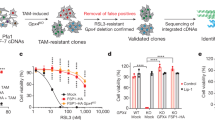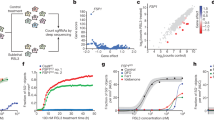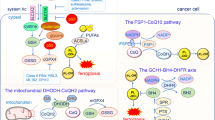Abstract
Ferroptosis is a non-apoptotic form of regulated cell death caused by the failure of the glutathione-dependent lipid-peroxide-scavenging network. FINO2 is an endoperoxide-containing 1,2-dioxolane that can initiate ferroptosis selectively in engineered cancer cells. We investigated the mechanism and structural features necessary for ferroptosis initiation by FINO2. We found that FINO2 requires both an endoperoxide moiety and a nearby hydroxyl head group to initiate ferroptosis. In contrast to previously described ferroptosis inducers, FINO2 does not inhibit system xc– or directly target the reducing enzyme GPX4, as do erastin and RSL3, respectively, nor does it deplete GPX4 protein, as does FIN56. Instead, FINO2 both indirectly inhibits GPX4 enzymatic function and directly oxidizes iron, ultimately causing widespread lipid peroxidation. These findings suggest that endoperoxides such as FINO2 can initiate a multipronged mechanism of ferroptosis.
This is a preview of subscription content, access via your institution
Access options
Access Nature and 54 other Nature Portfolio journals
Get Nature+, our best-value online-access subscription
$29.99 / 30 days
cancel any time
Subscribe to this journal
Receive 12 print issues and online access
$259.00 per year
only $21.58 per issue
Buy this article
- Purchase on Springer Link
- Instant access to full article PDF
Prices may be subject to local taxes which are calculated during checkout






Similar content being viewed by others
References
Elmore, S. Apoptosis: a review of programmed cell death. Toxicol. Pathol. 35, 495–516 (2007).
Lockshin, R. A. & Zakeri, Z. Programmed cell death and apoptosis: origins of the theory. Nat. Rev. Mol. Cell. Biol. 2, 545–550 (2001).
Dixon, S. J. et al. Ferroptosis: an iron-dependent form of nonapoptotic cell death. Cell 149, 1060–1072 (2012).
Yang, W. S. et al. Regulation of ferroptotic cancer cell death by GPX4. Cell 156, 317–331 (2014).
Cao, J. Y. & Dixon, S. J. Mechanisms of ferroptosis. Cell. Mol. Life. Sci. 73, 2195–2209 (2016).
Yang, W. S. et al. Peroxidation of polyunsaturated fatty acids by lipoxygenases drives ferroptosis. Proc. Natl. Acad. Sci. USA 113, E4966–E4975 (2016).
Crespo-Ortiz, M. P. & Wei, M. Q. Antitumor activity of artemisinin and its derivatives: from a well-known antimalarial agent to a potential anticancer drug. J. Biomed. Biotechnol. 2012, 247597 (2012).
Li, Z., Li, Q., Wu, J., Wang, M. & Yu, J. Artemisinin and its derivatives as a repurposing anticancer agent: what else do we need to do? Molecules 21, 1331 (2016).
Krishna, S. et al. A randomised, double blind, placebo-controlled pilot study of oral artesunate therapy for colorectal cancer. EBioMedicine 2, 82–90 (2014).
Abrams, R. P., Carroll, W. L. & Woerpel, K. A. Five-membered ring peroxide selectively initiates ferroptosis in cancer cells. ACS. Chem. Biol. 11, 1305–1312 (2016).
Hanahan, D. & Weinberg, R. A. Hallmarks of cancer: the next generation. Cell 144, 646–674 (2011).
Skouta, R. et al. Ferrostatins inhibit oxidative lipid damage and cell death in diverse disease models. J. Am. Chem. Soc. 136, 4551–4556 (2014).
Zilka, O. et al. On the mechanism of cytoprotection by ferrostatin-1 and liproxstatin-1 and the role of lipid peroxidation in ferroptotic cell death. ACS Cent. Sci. 3, 232–243 (2017).
Krainz, T. et al. A mitochondrial-targeted nitroxide is a potent inhibitor of ferroptosis. ACS Cent. Sci. 2, 653–659 (2016).
Gaschler, M. M. & Stockwell, B. R. Lipid peroxidation in cell death. Biochem. Biophys. Res. Commun. 482, 419–425 (2017).
Kagan, V. E. et al. Oxidized arachidonic and adrenic PEs navigate cells to ferroptosis. Nat. Chem. Biol. 13, 81–90 (2017).
Shimada, K. et al. Global survey of cell death mechanisms reveals metabolic regulation of ferroptosis. Nat. Chem. Biol. 12, 497–503 (2016).
Dixon, S. J. et al. Pharmacological inhibition of cystine-glutamate exchange induces endoplasmic reticulum stress and ferroptosis. ELife 3, e02523 (2014).
Yin, J. et al. Cyanine-based fluorescent probe for highly selective detection of glutathione in cell cultures and live mouse tissues. J. Am. Chem. Soc. 136, 5351–5358 (2014).
Ishii, T., Bannai, S. & Sugita, Y. Mechanism of growth stimulation of L1210 cells by 2-mercaptoethanol in vitro. Role of the mixed disulfide of 2-mercaptoethanol and cysteine. J. Biol. Chem. 256, 12387–12392 (1981).
Toppo, S., Flohé, L., Ursini, F., Vanin, S. & Maiorino, M. Catalytic mechanisms and specificities of glutathione peroxidases: variations of a basic scheme. Biochim. Biophys. Acta 1790, 1486–1500 (2009).
Beekman, A. C. et al. Stereochemistry-dependent cytotoxicity of some artemisinin derivatives. J. Nat. Prod. 60, 325–330 (1997).
Beekman, A. C. et al. Artemisinin-derived sesquiterpene lactones as potential antitumour compounds: cytotoxic action against bone marrow and tumour cells. Planta Med. 64, 615–619 (1998).
Burkhard, J. A., Wuitschik, G., Rogers-Evans, M., Müller, K. & Carreira, E. M. Oxetanes as versatile elements in drug discovery and synthesis. Angew. Chem. Int. Ed. Engl. 49, 9052–9067 (2010).
Wuitschik, G. et al. Oxetanes in drug discovery: structural and synthetic insights. J. Med. Chem. 53, 3227–3246 (2010).
Trost, B. M. & Bogdanow, M. J. New synthetic reactions—versatile cyclobutanone (spiroannelation) and gamma-butyrolactone (lactone annelation) synthesis. J. Am. Chem. Soc. 95, 5321–5334 (1973).
Fujioka, H. et al. Reaction of the acetals with TESOTf-base combination; speculation of the intermediates and efficient mixed acetal formation. J. Am. Chem. Soc. 128, 5930–5938 (2006).
Murai, A., Ono, M. & Masamune, T. Intramolecular cyclization of 3,4-epoxy alcohols—oxetane formation. Bull. Chem. Soc. Jpn. 50, 1226–1231 (1977).
Biemann, K. & Seibl, J. Application of mass spectrometry to structure problems. 2. Stereochemistry of epimeric, cyclic alcohols. J. Am. Chem. Soc. 81, 3149–3150 (1959).
Liu, Y. et al. Guanacastane-type diterpenoids with cytotoxic activity from Coprinus plicatilis. Bioorg. Med. Chem. Lett. 22, 5059–5062 (2012).
Ki, D. W. et al. New antioxidant sesquiterpenes from a culture broth of Coprinus echinosporus. J. Antibiot. (Tokyo) 68, 351–353 (2015).
Vilotijevic, I. & Jamison, T. F. Epoxide-opening cascades in the synthesis of polycyclic polyether natural products. Angew. Chem. Int. Ed. Engl. 48, 5250–5281 (2009).
Hwang, C., Sinskey, A. J. & Lodish, H. F. Oxidized redox state of glutathione in the endoplasmic reticulum. Science 257, 1496–1502 (1992).
Spangler, B. et al. A novel tumor-activated prodrug strategy targeting ferrous iron is effective in multiple preclinical cancer models. J. Med. Chem. 59, 11161–11170 (2016).
Fontaine, S. D., DiPasquale, A. G. & Renslo, A. R. Efficient and stereocontrolled synthesis of 1,2,4-trioxolanes useful for ferrous iron-dependent drug delivery. Org. Lett. 16, 5776–5779 (2014).
Davidson, B. S. Cytotoxic 5-membered cyclic peroxides from a plakortis sponge. J. Org. Chem. 56, 6722–6724 (1991).
D’Ambrosio, M., Guerriero, A., Debitus, C., Waikedre, J. & Pietra, F. Relative contributions to antitumoral activity of lipophilic vs. polar reactive moieties in marine terpenoids. Tetrahedr. Lett 38, 6285–6288 (1997).
Hurlocker, B., Miner, M. R. & Woerpel, K. A. Synthesis of silyl monoperoxyketals by regioselective cobalt-catalyzed peroxidation of silyl enol ethers: application to the synthesis of 1,2-dioxolanes. Org. Lett. 16, 4280–4283 (2014).
Park, S. E. et al. Induction of apoptosis in MDA-MB-231 human breast carcinoma cells with an ethanol extract of Cyperus rotundus L. by activating caspases. Oncol. Rep. 32, 2461–2470 (2014).
Yu, B. & Reynisson, J. Bond stability of the “undesirable” heteroatom-heteroatom molecular moieties for high-throughput screening libraries. Eur. J. Med. Chem. 46, 5833–5837 (2011).
Nam, W. et al. Effects of artemisinin and its derivatives on growth inhibition and apoptosis of oral cancer cells. Head Neck 29, 335–340 (2007).
Ooko, E. et al. Artemisinin derivatives induce iron-dependent cell death (ferroptosis) in tumor cells. Phytomedicine. 22, 1045–1054 (2015).
Barnes-Seeman, D. et al. Metabolically stable tert-butyl replacement. ACS Med. Chem. Lett. 4, 514–516 (2013).
Wang, X. et al. Spiro- and dispiro-1,2-dioxolanes: contribution of iron(II)-mediated one-electron vs two-electron reduction to the activity of antimalarial peroxides. J. Med. Chem. 50, 5840–5847 (2007).
Yant, L. J. et al. The selenoprotein GPX4 is essential for mouse development and protects from radiation and oxidative damage insults. Free. Radic. Biol. Med. 34, 496–502 (2003).
Hong, Y. et al. The role of selenium-dependent and selenium-independent glutathione peroxidases in the formation of prostaglandin F2α. J. Biol. Chem. 264, 13793–13800 (1989).
Dansen, T. B., Wirtz, K. W. A., Wanders, R. J. A. & Pap, E. H. W. Peroxisomes in human fibroblasts have a basic pH. Nat. Cell Biol. 2, 51–53 (2000).
Beasley, D. E., Koltz, A. M., Lambert, J. E., Fierer, N. & Dunn, R. R. The evolution of stomach acidity and its relevance to the human microbiome. PLoS ONE 10, e0134116 (2015).
Creek, D. J., Chiu, F. C. K., Prankerd, R. J., Charman, S. A. & Charman, W. N. Kinetics of iron-mediated artemisinin degradation: effect of solvent composition and iron salt. J. Pharm. Sci. 94, 1820–1829 (2005).
Wu, Y., Yue, Z. Y. & Wu, Y. L. Interaction of qinghaosu (artemisinin) with cysteine sulfhydryl mediated by traces of non-heme iron. Angew. Chem. Int. Ed. Engl. 38, 2580–2582 (1999).
Folch, J., Lees, M. & Sloane Stanley, G. H. A simple method for the isolation and purification of total lipides from animal tissues. J. Biol. Chem. 226, 497–509 (1957).
Boettcher, C., Pries, C. & Vangent, C. M. A rapid and sensitive sub-micro phosphorus determination. Anal. Chim. Acta 24, 203–204 (1961).
Tyurina, Y. Y. et al. A mitochondrial pathway for biosynthesis of lipid mediators. Nat. Chem. 6, 542–552 (2014).
Shimada, K., Hayano, M., Pagano, N. C. & Stockwell, B. R. Cell-line selectivity improves the predictive power of pharmacogenomic analyses and helps identify NADPH as biomarker for ferroptosis sensitivity. Cell Chem. Biol. 23, 225–235 (2016).
Acknowledgements
We thank C. Lin for assistance with NMR spectroscopy and mass spectrometry, C. Hu for X-ray analysis, along with the Materials Research Science and Engineering Center (MRSEC) program of the National Science Foundation (NSF) under Award Numbers DMR-0820341 and DMR-1420073, and J. Chung for assistance with cell culture. This research was supported by the Training Program in Molecular Biophysics Grant (T32GM008281 to M.M.G.), the National Cancer Institute (R35CA209896 and P01CA087497 to B.R.S), the National Institute of General Medical Sciences (1RO1GM118730 to K.A.W.), the National Heart, Lung, and Blood Institute (HL114453 to V.E.K. and Y.Y.T.), the National Institute of Allergy and Infectious Diseases (U19AI068021 to V.E.K. and Y.Y.T.) and the MRSEC Program of the National Science Foundation (DMR-1420073 to E.P.-P.). The Bruker Avance-400, 500 and 600 MHz spectrometers (NYU) were acquired through the support of the National Science Foundation (CHE-01162222).
Author information
Authors and Affiliations
Contributions
M.M.G., A.A.A., H.L., B.R.S. and K.A.W. contributed to the writing of the manuscript. M.M.G., A.A.A., L.K.M., V.E.K., B.R.S. and K.A.W. designed and planned research. M.M.G., A.A.A., H.L., J.M.C., D.W.H., D.S.Z., P.H.B., Y.Y.T. and J.D.D. conducted in vitro biochemical and metabolomic assays. M.M.G, A.A.A., B.H., C.A.V., D.W.H. and A.J.L. collected and analyzed cell viability data. L.F.Y. performed quantitative PCR. A.A.A. and H.L. conducted NMR studies. A.A.A. conducted stability studies. H.L. and E.R. conducted western blotting experiments. A.A.A., B.H. and D.S.Z. synthesized FINO2 and all structural analogues. A.Y.C. aided in furan synthesis. E.P.-P. aided in oxetane synthesis. M.A.F., A.V.B., V.V.S., A.J.L. and M.S.S. synthesized deuterated arachidonic acids. All authors have given their approval of the final version of the manuscript.
Corresponding authors
Ethics declarations
Competing interests
M.S.S. is the Chief Scientific Officer of Retrotrope, Inc.
Additional information
Publisher’s note: Springer Nature remains neutral with regard to jurisdictional claims in published maps and institutional affiliations.
Supplementary information
Supplementary Text and Figures
Supplementary Figures 1–14, Supplementary Table 1 and Supplementary Note
Rights and permissions
About this article
Cite this article
Gaschler, M.M., Andia, A.A., Liu, H. et al. FINO2 initiates ferroptosis through GPX4 inactivation and iron oxidation. Nat Chem Biol 14, 507–515 (2018). https://doi.org/10.1038/s41589-018-0031-6
Received:
Accepted:
Published:
Issue Date:
DOI: https://doi.org/10.1038/s41589-018-0031-6
This article is cited by
-
Harnessing ferroptosis for enhanced sarcoma treatment: mechanisms, progress and prospects
Experimental Hematology & Oncology (2024)
-
Role of ferroptosis in chronic kidney disease
Cell Communication and Signaling (2024)
-
Study on the differential hepatotoxicity of raw polygonum multiflorum and polygonum multiflorum praeparata and its mechanism
BMC Complementary Medicine and Therapies (2024)
-
Unlocking ferroptosis in prostate cancer — the road to novel therapies and imaging markers
Nature Reviews Urology (2024)
-
Ferroptosis in cancer: From molecular mechanisms to therapeutic strategies
Signal Transduction and Targeted Therapy (2024)



